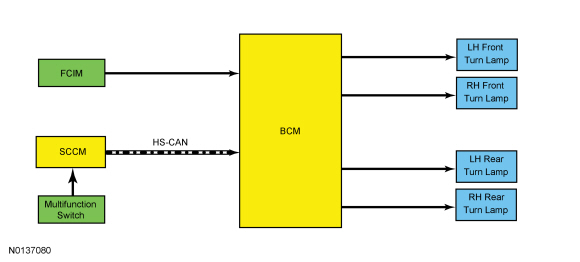SECTION 417-01: Exterior Lighting
| 2014 Flex Workshop Manual
|
DESCRIPTION AND OPERATION
| Procedure revision date: 05/02/2013
|
Overview
The turn lamp system consists of:
When the multifunction switch is placed in the left or right TURN position, the corresponding turn lamps flash on and off.
The hazard flasher switch is located in the center instrument panel finish panel (integrated into the FCIM ). When the hazard function is active, all the turn lamps flash on and off.
The front turn signal indicator lamps are integrated into the headlamp assemblies.
The rear turn signal indicator lamps operate independently of the stoplamps.
System Operation

Network Message Chart
BCM Network Input Messages
| Broadcast Message | Originating Module | Message Purpose |
|---|---|---|
| Turn signal switch_status | SCCM | Indicates the turn signal stalk position on the multifunction switch (left/right lane change or turn signal on or off) to the BCM . The BCM activates the left/right turn signals based on this input. |
Turn Signals
The SCCM monitors the multifunction switch position. When the multifunction switch is in the left or right turn position, the SCCM sends a turn signal switch status message over the communication network to the BCM indicating a request for the left or right turn signal
When the BCM receives a request for a turn signal, the BCM supplies on/off voltage to the appropriate turn lamps.
The timed on/off cycle for turn lamps is determined by the BCM and is set to flash approximately 80 times per minute if both the front and rear turn signal lamps operate correctly. If an individual turn signal lamp is inoperative, the BCM fast flashes the remaining turn lamp approximately 160 times per minute to indicate a bulb outage to the driver.
The multifunction switch is a momentary contact switch, with 2 detents for the left turn position and 2 detents for the right turn position. When placed in the first detent and released, the corresponding turn signals flash 3 times and turn off. When the multifunction switch is moved to the second detent and released, the turn signal flashes until the steering wheel is turned in the opposite direction (based on input from the steering wheel rotation sensor) or the vehicle travels farther than 3.22 km (2 mi). The SCCM monitors the steering wheel rotation sensor and the multifunction switch input to determine when to cancel the turn signals. The SCCM monitors the distance traveled to determine if the turn signal should be turned off.
The BCM also provides an overload protection of the turn lamp output circuits. When an excessive current draw is detected, the BCM disables the affected turn lamp circuit driver. Refer to FET in Section 419-10 .
Hazard Lamps
The BCM sends a voltage signal to the FCIM to monitor for a hazard lamp function request. When the hazard flasher switch is activated, the voltage signal is routed to ground, indicating a request to activate or deactivate the hazard lamp function
When the BCM receives a request for the hazard lamps, the BCM supplies on/off voltage to all the turn lamps.
The timed on/off cycle for the hazard lamps is approximately 80 times per minute regardless of bulb outage.